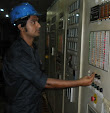Hazards due to leakage, breakdown or improper component assembly
● A fuel or gas pipe bursting and spraying fuel or gas
● A control oil pipe bursting and spraying oil (Common Rail)
● VIC housing bursting and spraying oil (if variable inlet close valve used)
● Leakage of:
● A control oil pipe bursting and spraying oil (Common Rail)
● VIC housing bursting and spraying oil (if variable inlet close valve used)
● Leakage of:
- fuel at joints on the low and/or high pressure side
- lube oil
- high pressure water on DWI engines
- HT water
- charge air
- exhaust gas
- pressurised air from air container, main manifold or pipes
- high pressure gas and sealing oil on GD engines
- pressurised air from air container, main manifold or pipes
- high pressure gas and sealing oil on GD engines
● Fire or explosion due to leakage from a fuel or gas line
● Fire or explosion due to flammable gas/vapour (crude oil) leaking into the insulation box
● Inhalation of exhaust gases or fuel gases due to leakage
● Failure of pneumatic stop
● Ejected components due to:
- breakdown of hydraulic tool
- breakdown of hydraulic bolt
- breakdown of turbocharger
- high firing pressures
- major failure
● Ejection of:
- pressurised liquids and gases from the engine block or piping
- high pressure fluid due to breakdown of hydraulic tool
- gas due to high firing pressures
- pressurised gases from high pressure gas system
- high pressure fluid due to breakdown of HP sealing oil pipe
- high pressure air from compressed air supply pipes during maintenance of pneumatically operated equipment
- cooling water or fuel/lube oil if sensor is loosened while the circuit is pressurised
- leaks during maintenance work
● Oil spray if running without covers
● Ejection of fuel injector if not fastened and:
- the turning device is engaged and turned
- the engine turns due to closed generator breaker or coupling.








No comments